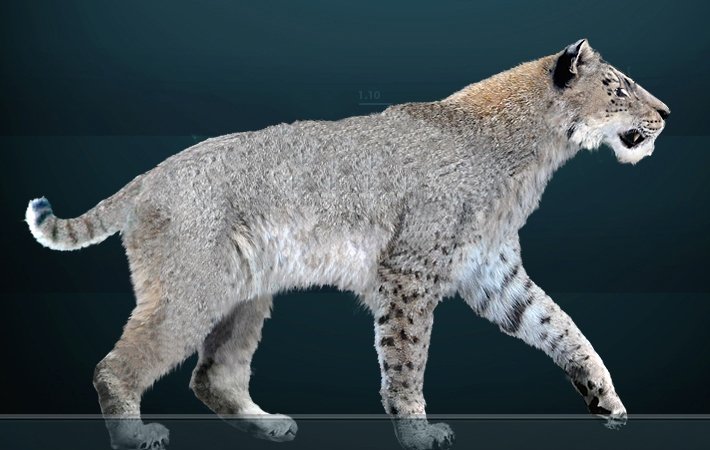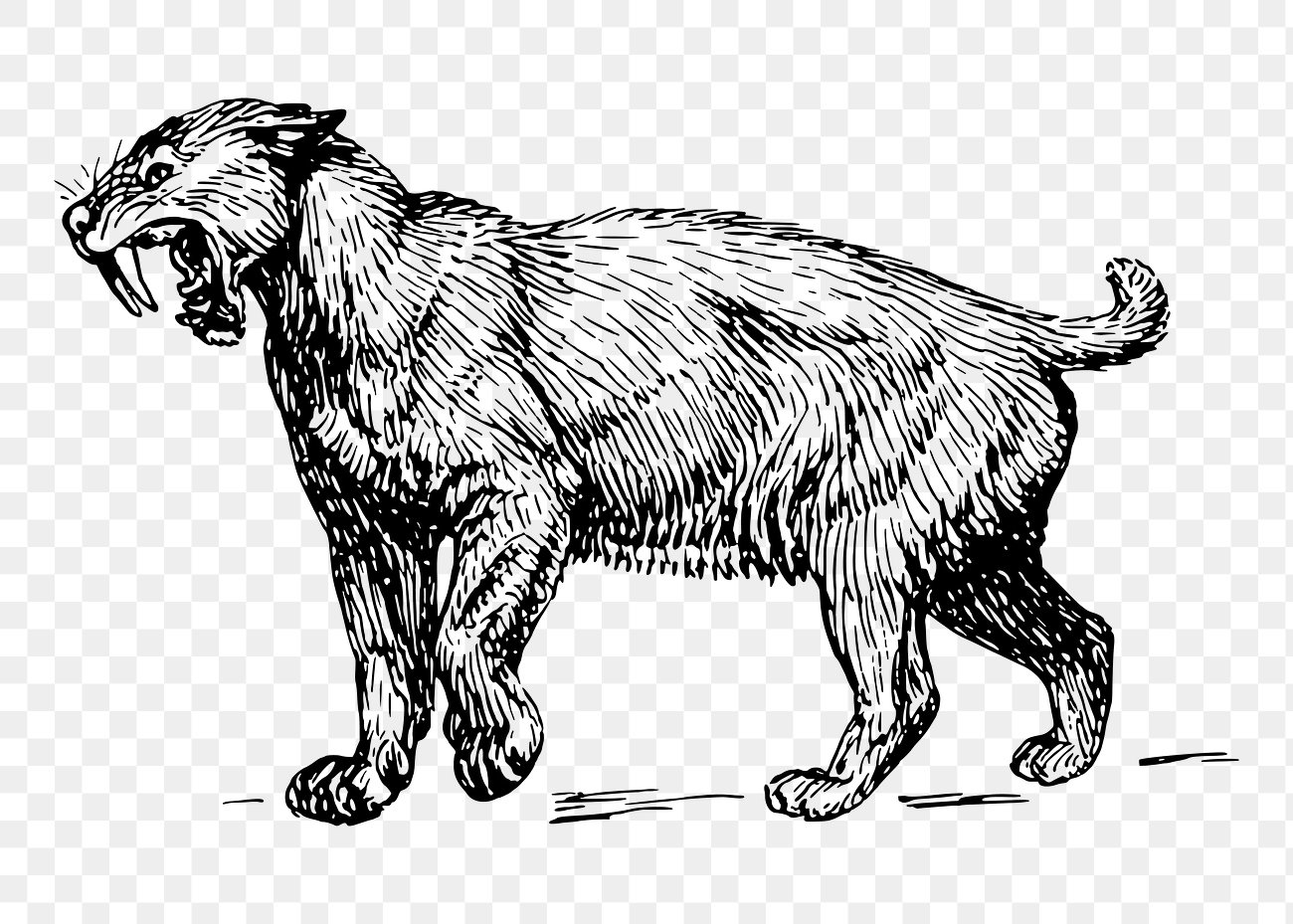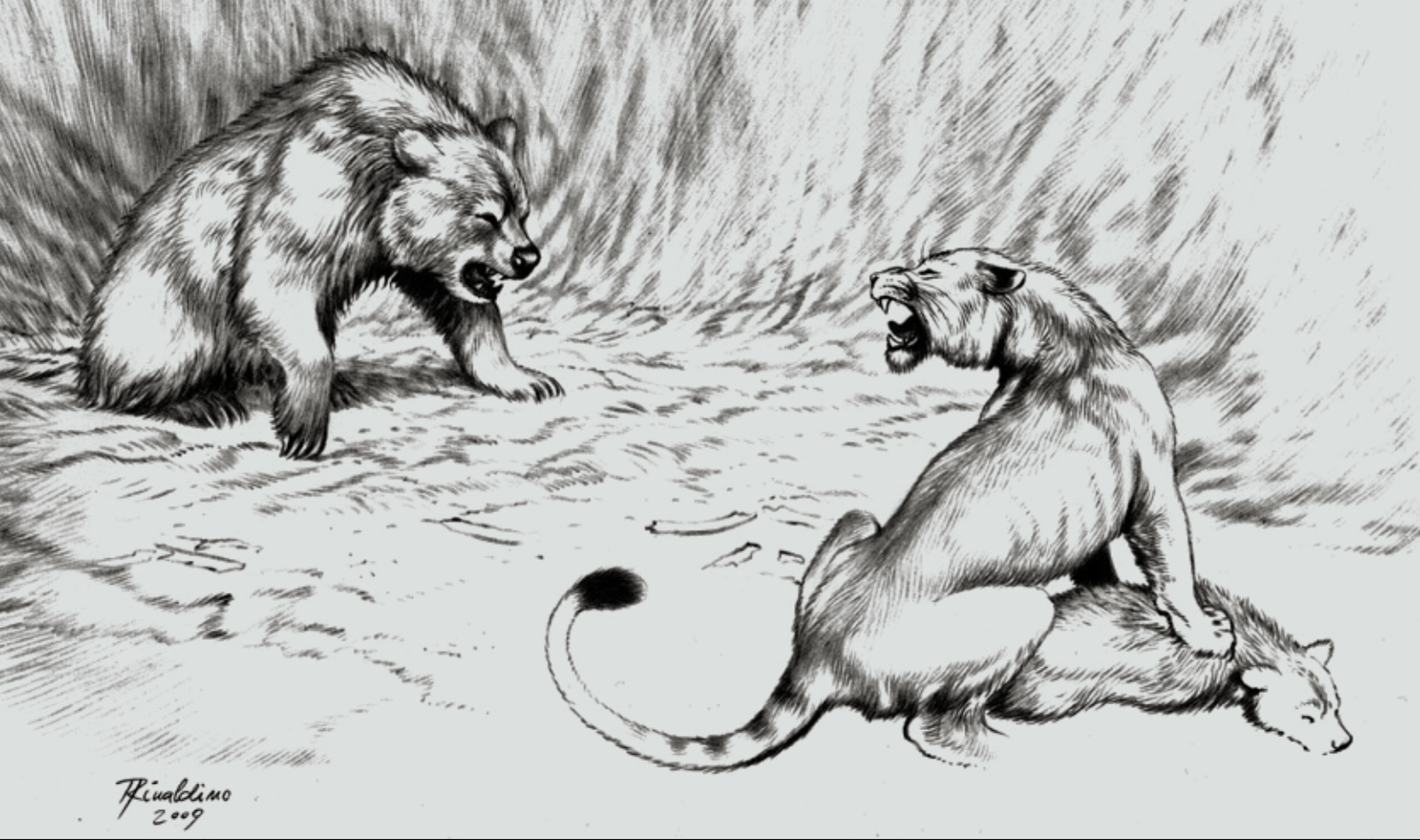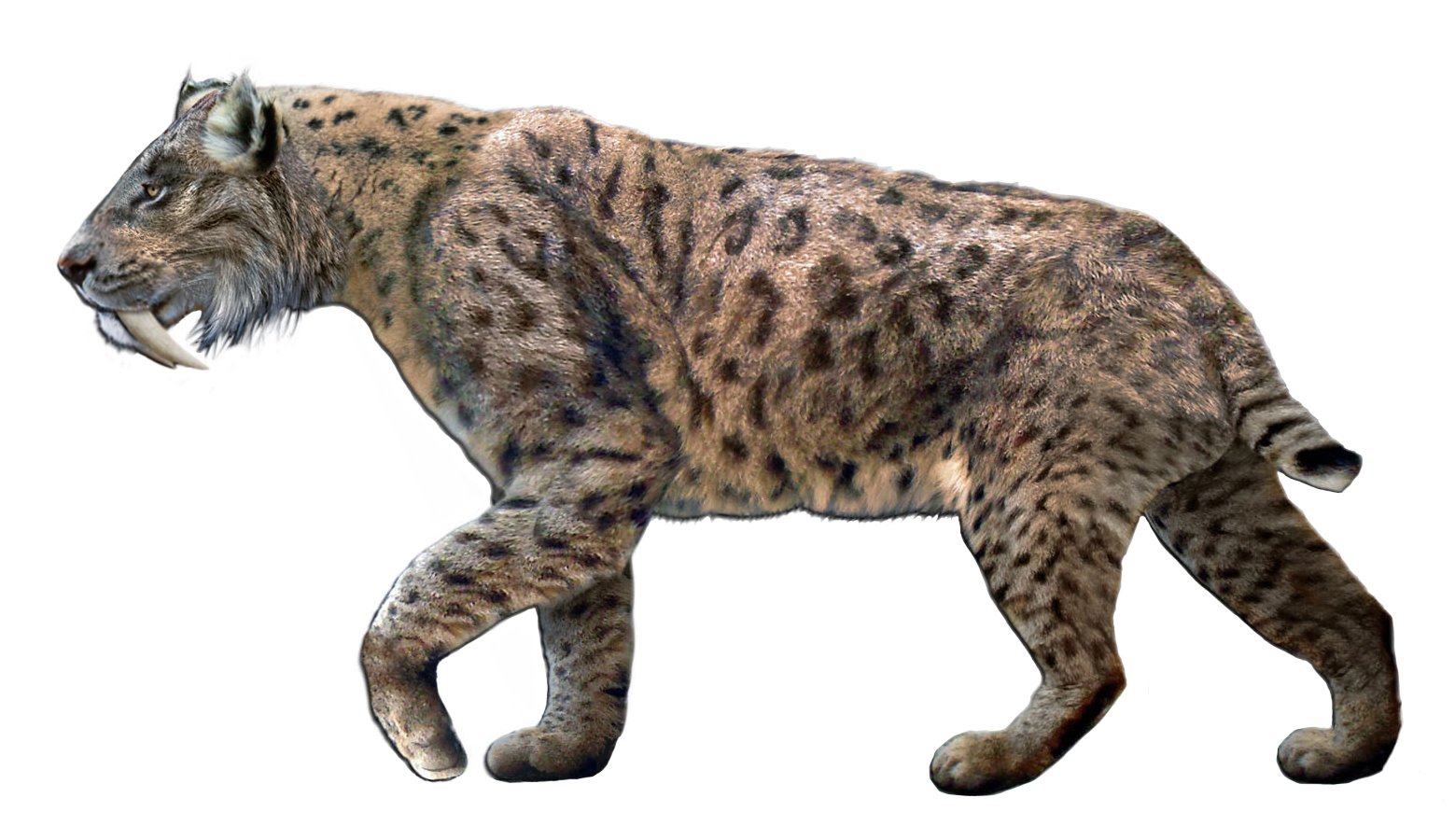Imagine walking a snowy plain, mammoths looming nearby, and knowing enormous cats once prowled in their shadow. These ancient felines were more than fierce predators—they were masters of survival, blending power, mystery, and resilience in equal measure. Long before house cats curled on our laps, their wild ancestors reigned over ice-chilled landscapes, shaping ecosystems and inspiring awe. What was it like to see a saber-toothed predator vanish into the mist, or hear the low growl of a feline built for a world of giants? The stories of these Ice Age cats tug at the heart and spark our curiosity, reminding us how much wonder lies buried in the bones of the past. Let’s step back into a world where the chill in the air was matched only by the thrill of knowing a big cat might be watching from the shadows.
The Mighty Smilodon’s Saber Teeth

What truly sets Smilodon apart is its legendary pair of saber-like fangs—each blade-like canine stretching up to seven inches. Just picturing that smile is enough to stir the imagination. This cat, often called the saber-toothed tiger (though not a true tiger), was built for drama and spectacle. Its jaws could open incredibly wide, making room for those intimidating teeth, which it likely used to target the throats of giant prey. Smilodon’s fangs were fragile, though, so it needed precision rather than brute force. There’s something humbling about imagining such a magnificent predator relying on delicate technique in a world of mammoths and giant sloths. The saber teeth became a symbol of the Ice Age’s wild beauty—both a gift and a vulnerability. It’s a reminder that even the fiercest creatures have their Achilles’ heel, and that nature’s designs are always a mix of power and limitation.
Cave Lions: Kings of the Frost

The Eurasian cave lion, Panthera spelaea, was a true monarch of the Ice Age steppe. Towering above today’s lions, these cats could weigh up to 770 pounds and stretch nearly four feet tall at the shoulder. They roamed vast, cold grasslands from western Europe all the way to Alaska, hunting reindeer, bison, and sometimes even young mammoths. Their thick, golden coats helped them blend with the pale landscape, while their powerful limbs made them agile enough to chase prey across snow and ice. Cave paintings from ancient humans sometimes show these lions without manes, hinting at a unique appearance. There’s something haunting about knowing our ancestors may have watched them from the shadows, learning from their grace and power. As rulers of a frozen domain, cave lions remind us how adaptable—and vulnerable—even the mightiest creatures can be.
Homotherium: The Scimitar Cat

Homotherium, often called the scimitar cat, was a relative of Smilodon with a look all its own. Instead of long, downward-curving fangs, Homotherium’s saber teeth were shorter and broader, shaped more like a curved sword. These cats had unusually long forelimbs and sloping backs, giving them a hyena-like profile. They roamed icy plains and open woodlands across Europe, Asia, and North America, using teamwork to hunt large prey like young mammoths and bison. Some scientists think they may have hunted in packs, which feels almost chilling to imagine—a group of sleek, muscular cats moving silently through the snow. Homotherium’s unique build and clever hunting strategies made it a specialist in its cold world. Its fossils leave behind a story of adaptation, reminding us that survival often means finding your own way to thrive.
American Lion: The Giant of the New World

The American lion, Panthera atrox, was a true titan of its time—the largest cat ever to roam North America. Bigger than today’s African lions, it could weigh over 900 pounds and was nearly twelve feet long, including its tail. Imagine crossing paths with a cat taller than a grown man’s hip! These lions preferred open habitats like prairies and woodlands, where they hunted massive prey such as camels, bison, and even horses. Their sheer size and strength make them both awe-inspiring and a little terrifying. It’s hard not to feel small and humble when you picture such a creature sprinting across the ancient plains. Despite their power, American lions vanished along with many Ice Age giants, a stark reminder that no species is too big to fall. Their legacy lives on in the bones beneath our feet and the stories we tell.
Panthera Blytheae: An Ancient Mystery

Panthera blytheae is a name few have heard, but this ancient cat holds a special place in feline history. Discovered in the Himalayas, its skull dates back over six million years—making it one of the oldest big cats ever found. Panthera blytheae likely resembled a snow leopard, with adaptations for cold mountain life. Its existence reveals that the roots of modern big cats stretch deep into prehistory, thriving in harsh, high-altitude environments long before mammoths and saber-tooths dominated the Ice Age. The fossil’s discovery was a reminder that many stories remain buried, waiting to be told. There’s a quiet thrill in realizing that each new find could rewrite what we know about feline evolution. Panthera blytheae’s world was one of snow and silence, where survival depended on patience, stealth, and a little bit of luck—traits passed down to cats today.
Machairodus: The Blade-Faced Predator

Machairodus is another saber-toothed cat, but it’s not just a copy of Smilodon. These cats lived across Europe, Asia, and Africa, sporting long, flattened canines that gave their faces a blade-like look. Their bodies were built for power, with massive forelimbs and jaws designed for quick, deep bites. Machairodus likely hunted large prey by ambushing them from cover—think of a giant tabby leaping onto an unsuspecting horse or buffalo. It’s almost cinematic, picturing that moment of explosive energy and precision. Despite their formidable build, these cats went extinct before the end of the Ice Age, their fossils now silent witnesses to a vanished world. Machairodus reminds us that even the sharpest tools can grow dull in the hands of time, but the image of a prehistoric cat with knife-edged teeth will never quite lose its edge.
Frozen Bones, Hidden Stories

Many of the stories we know about Ice Age cats come from bones pulled from frozen earth or deep caves. Each fossil is like a time capsule, holding secrets about how these cats lived, hunted, and died. It’s thrilling to think of paleontologists brushing dirt from a massive jawbone or piecing together a shattered skull, slowly bringing an ancient predator back to life, if only in our imagination. Some fossils show wounds from battles, others bear the marks of age or harsh winters. These bones also reveal how cats adapted to changing climates, shifting from open grasslands to icy forests as the world transformed. The discovery of a single tooth or claw can spark wonder and debate, reminding us that most of the past is still waiting to be uncovered. Every bone is a whisper from the wild heart of another age.
Cat Tracks in the Permafrost

Permafrost, the permanently frozen ground of the far north, is like nature’s freezer. Sometimes, it yields astonishing finds: a paw print pressed into ancient mud or even the mummified remains of a big cat, fur and whiskers still intact. These discoveries are rare and precious, offering a glimpse into the everyday life of Ice Age cats. Imagine the thrill of seeing claw marks beside those of a mammoth or wolf, all frozen in time together. Such finds make the past feel startlingly close—a reminder that the world we know is just a thin layer above untold histories. These moments evoke a sense of wonder, knowing that the ground beneath our feet hides stories of survival, struggle, and kinship. Each print or paw tells a humble tale: once, a cat walked here, and for a moment, the Ice Age world was alive with possibility.
Predators and Prey: The Ancient Dance

Life during the Ice Age was a constant dance between predator and prey. Big cats like Smilodon and Homotherium were at the top of the food chain, but their survival depended on the herds of mammoths, bison, and horses that roamed the frozen plains. These cats had to be clever, patient, and strong—choosing just the right moment to strike. The relationship was delicate, with every hunt shaping the balance of the ecosystem. Sometimes, the cats failed, and hunger sharpened their instincts even more. Other times, a successful hunt meant life for another day. This dance wasn’t just about survival—it was about respect, adaptation, and the relentless push of nature’s rhythms. Even now, watching a house cat stalk a toy mouse, you can sense echoes of this ancient ritual. The predator’s grace, the prey’s alertness—it’s all still there, just beneath the surface.
Adaptations for the Cold

Ice Age cats weren’t just big and strong—they were built for the cold. Many had thick, shaggy coats that insulated them against snow and wind, and some, like the cave lion, may have grown even thicker fur in the harshest winters. Their paws were wide and padded, perfect for stalking across icy ground without sinking. Some species developed special teeth or jaw muscles for tackling tough, frozen meat. Others relied on keen senses to find prey in the bleak, white landscape. These adaptations show just how resourceful cats can be when faced with new challenges. It’s inspiring to see how evolution shapes life, turning obstacles into opportunities. When you see your own cat fluff up in winter, remember that it’s just a tiny echo of the resilience that allowed its ancestors to thrive in a world of ice and giants.
Motherhood in the Ice Age

Motherhood is always a challenge, but for Ice Age cats, it was a true test of endurance and instinct. Imagine a female cave lion giving birth in a hidden den, snow piling up outside, while she guarded her cubs against hunger and predators. Food was scarce, so mothers had to be clever—sometimes moving their young to follow migrating herds or sharing kills with other females. The bond between mother and cub was everything; survival depended on warmth, milk, and lessons learned by watching and mimicking. Cubs grew quickly, learning to stalk, pounce, and hide. Every purr, nuzzle, and playful swat was a small victory over the cold and danger outside. The tenderness of these moments, set against the harshness of the Ice Age, is a reminder that love and care have always been at the heart of the feline world.
Hunting Techniques: Power and Precision

Each Ice Age cat developed its own way of hunting, tailored to the landscape and prey around them. Smilodon, with its massive forelimbs, likely ambushed large, slow-moving animals, using sheer power to bring them down. Homotherium, on the other hand, may have relied on speed, slashing at prey with its shorter saber teeth before retreating to let blood loss do the work. Cave lions used teamwork, coordinating attacks much like modern lions, but in snow rather than savannah. These hunting strategies required more than muscle—they demanded patience, intelligence, and the ability to learn from experience. Watching our own cats stalk a feather toy, you can see sparks of this ancient skill. It’s humbling to realize how much of the Ice Age survives in their every move, a living link to a time when hunting was both art and necessity.
Competition at the Top

Being a top predator in the Ice Age wasn’t easy. Big cats faced fierce competition from other carnivores—dire wolves, short-faced bears, and packs of hyenas all vied for the same prey. Sometimes, these rivals clashed over a carcass, each trying to assert dominance. Other times, they avoided one another, hunting at different times or in different places. The struggle for survival was relentless, with every hunt a gamble. Some fossils show bite marks from battles lost and won, silent evidence of lives lived in constant tension. The drama of these encounters feels almost cinematic, but for the cats, it was daily reality. Their ability to adapt, to fight or flee, shaped not just their own fate but that of the entire Ice Age ecosystem. Even today, the spirit of competition lives on in every playful tussle between kittens, a gentle echo of ancient rivalries.
The Sound of the Ice Age Night

Imagine a sky full of stars, the world hushed under a blanket of snow—then, suddenly, the deep roar or yowl of a big cat echoing across the plain. Ice Age cats were not silent hunters. Their calls could travel for miles, warning rivals, calling for mates, or rallying family members. The sound must have been both thrilling and terrifying to ancient humans huddled in their shelters. Even today, the roar of a lion or the scream of a mountain lion carries a primal energy, a memory of wilder times. These vocalizations helped cats stake their claim on a territory, find lost cubs, or threaten competitors. In the dark, when sight failed, the voice became a lifeline—a way to connect across vast, empty spaces. The sounds of the Ice Age have faded, but the echoes remain in the purrs and meows we hear at home.
Climate Change and Cat Survival

As the Ice Age drew to a close, the world warmed and transformed. Grasslands became forests, prey animals shifted their ranges, and the old hunting grounds disappeared. Many big cats struggled to adapt, their bodies and behaviors finely tuned to the cold. Some found new niches, moving into different habitats or changing diets. Others, like Smilodon and the American lion, slipped away into extinction. The story of these cats is a lesson in resilience—and in vulnerability. Climate change is not just a modern problem; it’s a force that has shaped life for millions of years. Today, as our own world heats up, the fate of wild cats remains uncertain. Their past is a mirror, reflecting both the risks and the hope for survival if we act wisely. The legacy of Ice Age cats urges us to protect the wild places that still exist, for their sake and ours.
Lessons from the Ice: Modern Big Cats

Modern big cats—lions, tigers, leopards, and snow leopards—carry the legacy of their Ice Age ancestors. Their strength, agility, and beauty are a testament to millions of years of evolution and survival. Yet, they face many of the same challenges: changing climates, shrinking habitats, and competing predators (now, mostly humans). The stories of ancient cats remind us that even the greatest can fall when the world shifts beneath their feet. Conservation efforts today aim to protect what remains, to ensure that the roar of a lion or the stealth of a leopard does not vanish from the Earth. The humility and resilience of Ice Age cats inspire hope—they found ways to survive against the odds. Maybe, by learning from their story, we can ensure that modern felines have a future as rich as their past.
Small Cats, Big Connections

It’s easy to focus on the giants, but Ice Age landscapes were also home to smaller wildcats—lynxes, bobcats, and ancestors of our house cats. These little hunters thrived in the shadow of mammoths, weaving through forests and grasslands, catching birds and rodents. Their survival depended on adaptability and stealth, traits that carried forward into today’s house cats. Watching a domestic cat crouch and pounce, you can see the echoes of ancient instincts honed over thousands of years. Small cats may lack the dramatic saber teeth or giant size, but their story is just as powerful. They remind us that resilience comes in all shapes and sizes, and that greatness is not measured by bulk alone. The connection between small and big cats is a thread that links the Ice Age to our living rooms—a quiet, persistent legacy of survival.
Genetic Legacies: Traces in Today’s Cats

The DNA of modern cats holds secrets from the Ice Age. Scientists have found genetic traces linking today’s lions, leopards, and even domestic cats to their ancient relatives. These connections explain many of the behaviors and traits we see—like a lion’s roar, a snow leopard’s grip, or a tabby’s cautious curiosity. Some genes helped cats adapt to cold, while others shaped their hunting instincts. It’s astonishing to think that every purr, every leap, carries a whisper from a world of mammoths and saber-tooths. Studying these genetic legacies helps us understand not just where cats came from, but how they might survive the challenges ahead. In a way, every cat is a living fossil, a bridge between the deep past and the uncertain future. Their story is written in bone, fur, and the code of life itself.
Why We Love the Wild in Cats

There’s something about cats that stirs the imagination—their independence, their grace, their mysterious eyes that seem to see another world. Our fascination goes beyond the comfort of a purring companion on the couch; it reaches back to a time when cats were both awe-inspiring and a little bit dangerous. Ice Age cats remind us that wildness is part of the feline soul, a thread that runs from Smilodon to the kitten chasing shadows on your wall. This wildness is not just about hunting or surviving—it’s about curiosity, courage, and the quiet confidence that comes from knowing your place in the world. Loving cats means loving a piece of deep time, a connection to a world bigger and wilder than we can imagine. In every stretch, every leap, the wild heart of the Ice Age lives on.
Fossil Finds: New Discoveries Ahead

Despite all we know, the story of Ice Age cats is far from complete. Every year, new fossils are unearthed—teeth, bones, and sometimes entire skeletons that change our understanding of what these cats were like. Each discovery is a moment of excitement and wonder, reminding us that the Earth still holds secrets waiting to be revealed. Sometimes, a single bone can rewrite the history of a species or add a new branch to the feline family tree. For scientists and cat lovers alike, the thrill of discovery never fades. It’s a humbling reminder that our knowledge is always growing, shaped by curiosity and the willingness to look deeper. Who knows what new cats might be waiting to be found, locked in ice or stone? The adventure is far from over.
Conclusion

There’s a certain magic in knowing the world was once ruled by cats as grand and mysterious as the Ice Age giants. Their stories are not just about power or survival, but about adaptation, connection, and the enduring spark that makes felines so captivating. From the mighty saber-tooths to the smallest wildcats, each left a mark on the world—and on our hearts. As we marvel at the cats in our lives today, let’s remember the wildness they carry within. The past whispers through every purr and playful leap, inviting us to imagine a world where mammoths roamed and big cats watched from the shadows. Did you expect such wonder hidden in the feline family tree?

Suhail Ahmed is a passionate digital professional and nature enthusiast with over 8 years of experience in content strategy, SEO, web development, and digital operations. Alongside his freelance journey, Suhail actively contributes to nature and wildlife platforms like Feline Fam, where he channels his curiosity for the Feline into engaging, educational storytelling.
With a strong background in managing digital ecosystems — from ecommerce stores and WordPress websites to social media and automation — Suhail merges technical precision with creative insight. His content reflects a rare balance: SEO-friendly yet deeply human, data-informed yet emotionally resonant.
Driven by a love for discovery and storytelling, Suhail believes in using digital platforms to amplify causes that matter — especially those protecting Earth’s biodiversity and inspiring sustainable living. Whether he’s managing online projects or crafting wildlife content, his goal remains the same: to inform, inspire, and leave a positive digital footprint.






